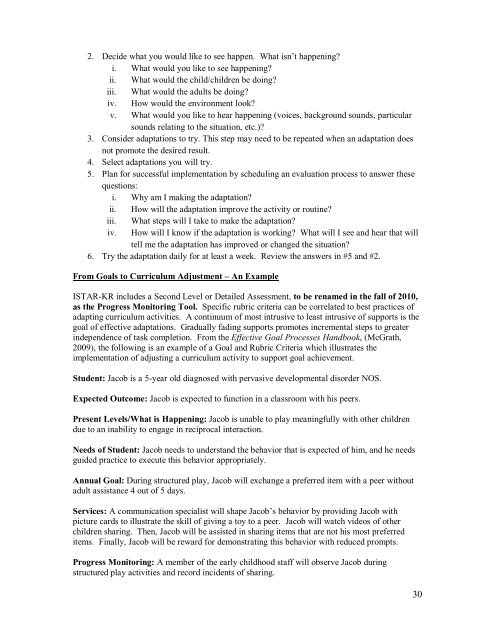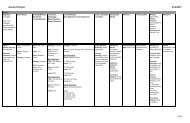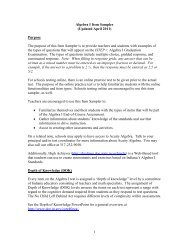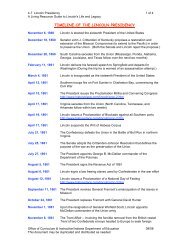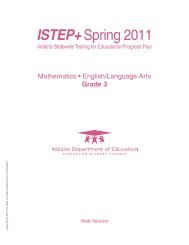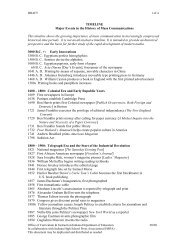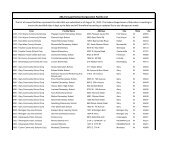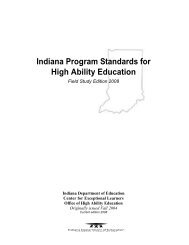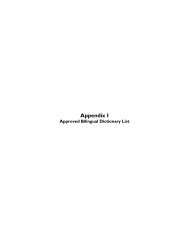Early Childhood ISTAR-KR Assessment Handbook - Indiana ...
Early Childhood ISTAR-KR Assessment Handbook - Indiana ...
Early Childhood ISTAR-KR Assessment Handbook - Indiana ...
Create successful ePaper yourself
Turn your PDF publications into a flip-book with our unique Google optimized e-Paper software.
2. Decide what you would like to see happen. What isn’t happening?<br />
i. What would you like to see happening?<br />
ii. What would the child/children be doing?<br />
iii. What would the adults be doing?<br />
iv. How would the environment look?<br />
v. What would you like to hear happening (voices, background sounds, particular<br />
sounds relating to the situation, etc.)?<br />
3. Consider adaptations to try. This step may need to be repeated when an adaptation does<br />
not promote the desired result.<br />
4. Select adaptations you will try.<br />
5. Plan for successful implementation by scheduling an evaluation process to answer these<br />
questions:<br />
i. Why am I making the adaptation?<br />
ii. How will the adaptation improve the activity or routine?<br />
iii. What steps will I take to make the adaptation?<br />
iv. How will I know if the adaptation is working? What will I see and hear that will<br />
tell me the adaptation has improved or changed the situation?<br />
6. Try the adaptation daily for at least a week. Review the answers in #5 and #2.<br />
From Goals to Curriculum Adjustment – An Example<br />
<strong>ISTAR</strong>-<strong>KR</strong> includes a Second Level or Detailed <strong>Assessment</strong>, to be renamed in the fall of 2010,<br />
as the Progress Monitoring Tool. Specific rubric criteria can be correlated to best practices of<br />
adapting curriculum activities. A continuum of most intrusive to least intrusive of supports is the<br />
goal of effective adaptations. Gradually fading supports promotes incremental steps to greater<br />
independence of task completion. From the Effective Goal Processes <strong>Handbook</strong>, (McGrath,<br />
2009), the following is an example of a Goal and Rubric Criteria which illustrates the<br />
implementation of adjusting a curriculum activity to support goal achievement.<br />
Student: Jacob is a 5-year old diagnosed with pervasive developmental disorder NOS.<br />
Expected Outcome: Jacob is expected to function in a classroom with his peers.<br />
Present Levels/What is Happening: Jacob is unable to play meaningfully with other children<br />
due to an inability to engage in reciprocal interaction.<br />
Needs of Student: Jacob needs to understand the behavior that is expected of him, and he needs<br />
guided practice to execute this behavior appropriately.<br />
Annual Goal: During structured play, Jacob will exchange a preferred item with a peer without<br />
adult assistance 4 out of 5 days.<br />
Services: A communication specialist will shape Jacob’s behavior by providing Jacob with<br />
picture cards to illustrate the skill of giving a toy to a peer. Jacob will watch videos of other<br />
children sharing. Then, Jacob will be assisted in sharing items that are not his most preferred<br />
items. Finally, Jacob will be reward for demonstrating this behavior with reduced prompts.<br />
Progress Monitoring: A member of the early childhood staff will observe Jacob during<br />
structured play activities and record incidents of sharing.<br />
30


